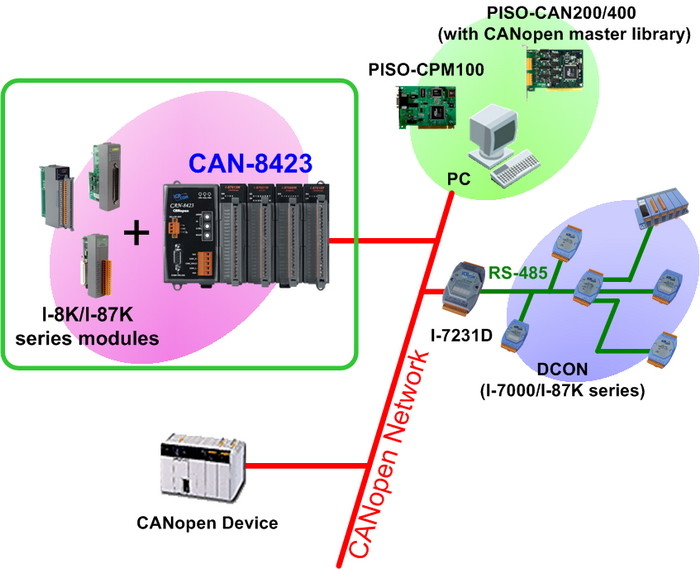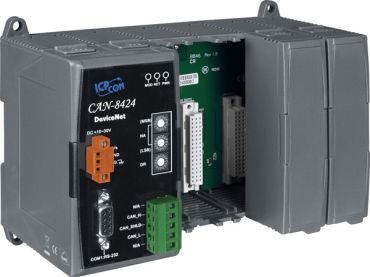ICPDAS CAN-8423
CANopen Embedded Device with 4 I/O Expansions
● NMT: Slave
● Error Control: Heart beat to Node Guarding selectable
● No. of SDOs: 1 Server, 0 Client
● No. of PDOs: 16Rx, 16Tx
● PDO Modes: Event Triggered, Remotely requested, Cyclic and Acyclic SYNC
● Emergency Message available
● CANopen Version: DS-301 v4.01
● CANopen Version: DS-301 v4.02
● Device Profile: DSP-401 v2.0
● Produce EDS file Dynamically
● CAN, ERR, and Tx/Rx LED indicator
CANopen, a kind of communication protocols, is based on the intelligent field bus (CAN bus). It was developed as a standardized embedded network with highly flexible configuration capabilities.
It provides standardized communication objects for real-time data (Process Data Objects, PDO), configuration data (Service Data Objects, SDO), network management data (NMT message, and Error Control), and special functions (Time Stamp, Sync message, and Emergency message). By now, CANopen is used in many various application fields, such as medical equipment, off-road vehicles, maritime electronics, public transportation, building automation and etc.
ICPDAS 8000 Series I/O Unit CAN-8423 main control unit is specially designed for the slave device of CANopen protocol. It follows the CANopen Spec DS-301 V4.02 and DSP-401 V2.1, and supplies many features for users, such as dynamic PDO, EMCY object, error output value, SYNC cyclic and acyclic, … and etc.
In order to expand I/O channel more flexible, an ICPDAS 8000 Series I/O Unit CAN-8423 supports up to 4 slots for I/O expansion and suits with a lot of ICP DAS DI / AI / DO / AO modules.
User can choose DI/DO/AI/AO modules of I-87K series or I-8000 series to fit the customized practice applications. In addition, we also provide CAN-8423 Utility to allow users to create the EDS file dynamically. The EDS file is based on CANopen DSP-306 and can be compatible with different CANopen master interfaces. The application architecture is as follows.
APPLICATIONS
● Industrial Machinery
● Laboratory Equipment & Research
● Restaurant Appliances
● Maritime
● Medical
● Specialty Vehicles

UTILITY
DESIGN FLOWCHART
The following simple steps show how to use ICPDAS 8000 Series I/O Unit CAN-8423 in the CANopen protocol.

| CPU | 80186, 80 MHz or compatible |
| SRAM/Flash/EEPROM | 512 KB / 512 KB / 2 KB |
| NVRAM | 31 bytes (battery backup, data valid for up to 10 years) |
| RTC (Real Time Clock) | Yes |
| Watchdog | CPU built-in |
| Expansion Slot | 4 slots |
| Controller | NXP SJA1000T with 16 MHz clock |
| Transceiver | NXP 82C250 |
| Connector | 5-pin screwed terminal block (N/A, CAN_L, CAN_SHLD, CAN_H, N/A) |
| Baud Rate | 10 k, 20 k, 50 k, 125 k, 250 k, 500 k, 800 k, 1 M (allow user-defined baud rate) |
| Transmission Distance | Depend on baud rate (for example, max. 1000 m at 50 kbps ) |
| Isolation | 3000 VDC for DC-to-DC, 2500 Vrms for photo-couple |
| Terminator Resistor | Jumper for 120 Ω terminator resistor |
| Specification | ISO-11898-2, CAN 2.0A and CAN 2.0B |
| Protocol | CANopen DS-301 v4.02, DS-401 v2.1 |
| COM1 | RS-232 (for configuration) |
| Round LED | PWR LED, RUN LED, ERR LED |
| Power Supply | Unregulated +10 ~ +30 VDC |
| Dimensions (w x l x h) | 188 x 132 x 91mm |
| Operating Temperature | -25 °C ~ +75 °C |
| Storage Temperature | -30 °C ~ +80 °C |
| Humidity | 10 ~ 90% RH, non-condensing |





